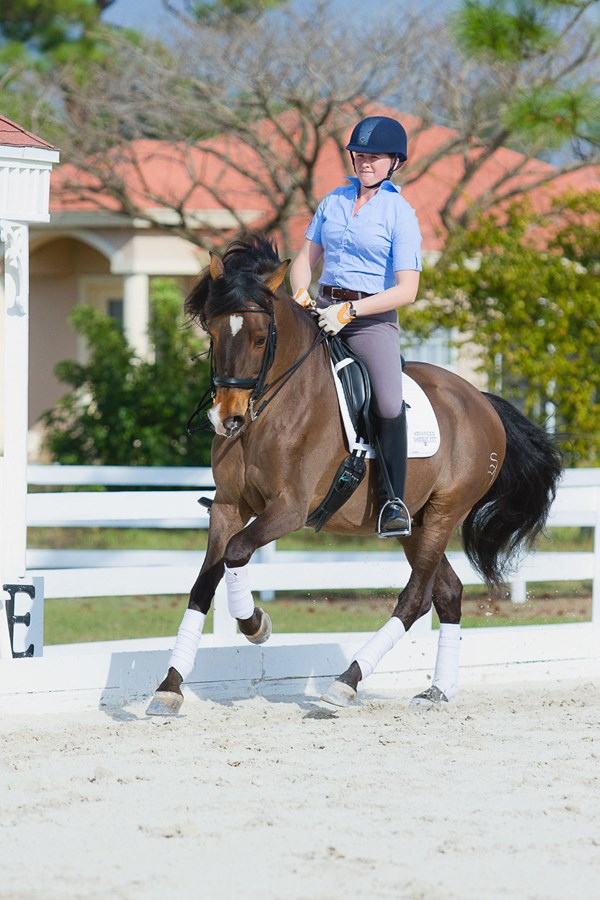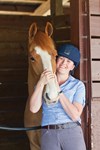Last month I wrote about the wonders of the hot horse, but a high-energy partner isn’t for everyone. Some riders prefer the security of a more laid-back mount; others might want to participate in disciplines where a quiet temperament is preferred or they might want to share their horses with their families.
Whatever the reason, a cooler-tempered horse presents its own management challenges for competition and training success. But with the right management, that even-keeled nature can be a terrific asset.

When I think of a cold-tempered horse, I think first of a horse who’s particularly slow to the aids. Now, any horse, including a hot type, can be behind the aids, but a cooler type is consistently slow to respond and needs constant reminders to stay sensitive.
Many riders are familiar with this type: the sweet, gentle horse you rode in your first lessons at the local riding stable or club. When learning how to post on the right diagonal or pick up the right lead, a rider needs a horse that, when things go wrong, would rather stop than bolt away. But that gentle nature is usually accompanied by duller responses to leg and seat aids, even when correctly applied. Low levels of responsiveness to the aids are a common quality in cold horses.
Those qualities were present in my former Young Rider horse, L’Etoile, a Holsteiner gelding I won with at Dressage at Devon. “Struppie” was not for a beginner; he was another kind of cold. He was not insensitive; in fact, he could be too sensitive to the aids. But he was quick to bring a “no thanks” answer to my questions. One of his favorite hobbies was kicking out at the leg. Struppie needed to be constantly reminded that I was the boss and that he had to put in as much, if not more, than his rider. The cold horse can be hard to keep motivated and he might respond to the aids, but he might need many more reminders to continue doing his job.
Cold horses can also be hard to keep fit. I’ve ridden several Friesians over the years, all of whom could be made quick to the aids, even to inspire, but they quickly get winded or muscle-fatigued even when in regular work. The weekly plan for Don Giovanni, a Hanoverian gelding I trained to Third Level, included gallop sets, jumping and hill work for conditioning. But at the horse show he had a simple warm-up: walk on a long rein, canter, a flying change each way, then half-steps to the ring. His first five minutes were his best five minutes, and I didn’t want to leave them in the locker room so I developed a strategy to put my best horse down centerline.
There’s also what I call the “faux cold” horse. Take Karateka III, for example. He is a Pura Raza Española (PRE) stallion we bought for my mom, a safetyconscious rider. I wanted something trained, comfortable and attractive for her, but my primary concern was safety so I was willing to sacrifice sensitivity to the aids in exchange for security. “Tres” fit the bill but is like a diesel engine. No matter who rides him (myself, my mom or one of my working students), the first five minutes of every ride are spent revving his engine and warming his spark plugs. Once he gets cruising, though, Tres shifts into a whole new gear. And the longer I’ve known him and the higher up the levels he’s gone, he has become quite sensitive to the aids and can even be a little hot. Now Tres has the potential to go either way. I can hop on and produce a whole Grand Prix test now, keen and zippy, or my mom can get on and have a quiet, pleasant schooling session or hack. Tres was a more sensitive ride masquerading as a cold horse, and with consistent training he’s become one of the best horses I’ve ever had the pleasure of riding.
Heating Things Up
While easier on some horses than others, sensitivity to the aids is learned, not innate. If your horse is particularly dull to the aids, raise the standards: He must not only respond immediately to the aid, he must respond to the tiniest aid. And you can get creative in using aids other than your leg for “go.”
Exercise 1—Subtle, forward aid:
1. After walking your horse on a long, loose rein, gather the reins to working length and come to a halt.
2. From the halt, engage your core and lift yourself forward and out of the saddle, barely out—as if someone has put a thumbtack on your saddle that you don’t want to sit on. This is the aid for your horse to move forward.
3. If your horse does not respond to this aid, give him a clear, quick kick or touch with the whip.
He probably won’t respond the first time; in fact, it may take him three, four or five attempts. But he’ll soon learn that if he responds to the light, comfortable aid—the lightening of his rider’s seat— he’ll be spared the kick. His life is easier when he listens to the tiny aid.
Exercise 2—Refined walk–trot transitions: Repeat the same thing at trot.
1. At medium walk, sit lightly.
2. If he doesn’t trot off immediately, come with the same sharper aid of the leg or touch of the whip. If he doesn’t trot even from the kick, continue until he does. He’ll figure it out. Consistency is key. Your horse needs to understand that if he fails to respond to the light touch of your aid, he’ll be the worse for it, every time.
Exercise 3—Refining the forward aids within the gaits: A light seat can help improve transitions within the gaits as well.
1. In the canter, sit normally through the short side of the arena.
2. When you come to the long side, sit in your new light seat and ask softly for medium canter. If your horse doesn’t immediately take off, respond with your aids in a clear, assertive way.
Repeat this until you feel him really take you down the long side as he associates that light seat with “Go! Now!”
The light seat as a go aid combined with a little repetition (so he starts to anticipate long sides at canter meaning “go”) will help make your cold horse not only more sensitive to the aids but a little more self-motivated.
Exercise 4—Teach your horse to anticipate: A horse that is looking for your next move can be an asset, particularly in the cold horse. You want him to anticipate. Here is a great exercise for building this in your horse:
1. Take a 20-meter circle and ride a transition every six strides: walk, trot, canter, in no particular order.
2. If you’ve repeated the same transition a few times and he’s starting to anticipate it, change to a different one.
3. Once he’s become eager for the next aid, take the exercise to a serpentine, but don’t be married to the pattern. Maybe after a few serpentines, make your middle loop a circle for a few times then go back to changing direction.
The goal of this exercise is to keep your horse guessing to increase his awareness of you. If he doesn’t know what’s coming next, he has to pay particularly close attention and be constantly alert.
The Spice of Life
Where the hot horse can benefit from consistency and routine, the cold horse really improves with variety for stimulation. Keep your workouts creative. Use cavalletti or light jumping. Both are great for any horse, of course, because they build strength and dexterity, but for the less-motivated horse they can provide a welcome change of pace from traditional arena work and patterns.
Don’t be confined by the arena. Work outside, in flat fields or on hills. If you aren’t lucky enough to have access to open spaces at your home facility, consider traveling to another trainer’s farm. We are lucky to have lots of open space at my farm, and many times my students take their lessons out on our hills. I’ll have their colder horses gallop or ride medium trot uphill to get them thinking forward, then make collected work downhill to improve coordination and enhance the conditioning of the hind end.
Don’t be afraid to mix it up with other disciplines. Many eventing Group Member Organizations offer a baby division at their horse trials with fences as low as 18-inch crossrails.
Fox hunting can be a little intimidating if your horse has never participated, but hunts usually offer group trail rides or beagling in the summertime, both at a slower pace. Hunter paces, too, are great fun for horse and rider and can help your colder-tempered dressage horse kick it up a notch. All of these events are places where cold horses shine because there’s nothing worse than wondering where your brakes are while approaching a solid obstacle on a hot, fire-breathing dragon!
Fitness work has dual benefits: It’s a change of pace for the dressage horse as well as an important element in helping the unmotivated horse find his “go” button. In routine work, keep your workouts short, interrupted by walk breaks. That will help your horse keep his heart rate up without building up lactic acid in the muscles. Sets of trot or canter work, particularly out on gentle hills, boost fitness and can be fun work out of the arena. We even work our horses in our pond for fun and fitness, though I’m careful not to let them swim too much because horses kick out behind them while swimming, which can tax the sacroiliac joint.
Clarity and Consistency
Keeping the work fun and fresh is good for both horse and rider. But at the end of the day, your horse needs to respond to your aids and be in front of the leg all the time, on the trails or on the centerline. Every time you put your feet in the irons, you’re training your horse so commit yourself to consistency in your demands and clarity in your aids. Don’t nag your horse to stay in front of you; demand it with authority. Don’t sometimes let your horse be lax in his responses; require that he always respond to your aid, no matter where you are.
When you are clear in your requirements and your aids, your laid-back horse will learn to be more sensitive, more responsive and more of a pleasure to ride. You’ll have a partner that is a reliable, consistent Steady Eddy both in his training and in his temperament.

Lauren Sprieser is a U.S. Dressage Federation bronze, silver and gold medalist and a U.S. Equestrian Federation Invite-Listed rider. She has trained several horses from green to the international levels, including the 10-year-old Westfalen mare Ellegria (2010 BLM Champion at Intermediaire II) and the 9-year-old Dutch harness gelding Victorious (2010 BLM Champion at Prix St. Georges). Both will compete at Grand Prix this year. Lauren trains horses and riders in Marshall, Virginia (spriesersporthorse.com).











